Understanding Our Environment

August 2022 Issue
Understanding Our Environment is the internal newsletter for the Kansas Biological Survey & Center for Ecological Research community. Please email biosurvey@ku.edu regarding any errors or omissions.
Photo: The Dimensions in Biodiversity research site at the KU Field Station in late July.
Comings and Goings
In mid-June Samantha Meisenheimer joined KU IT and became our new IT support technician following Jeremy McLeod’s promotion. She came to KU from the private sector with a strong background in IT support and technology troubleshooting. Samantha’s office is Higuchi 118, and she is ready to help. Please reach out at samanthameisenheimer@ku.edu.
In early August, Wendy Holman joined us as education program coordinator for the KU Field Station. She has been a middle school science teacher for six years (here in Lawrence and in Alaska) and has previous experience as a researcher and as an environmental educator in a variety of settings. Her office is at the Armitage Center. (That’s Wendy, in the cap and facing the camera, working with middle school students visiting the Field Station as part of Green Works KC’s ECO Careers Camp in early August. Photo by Sheena Parsons, Field Station manager.)
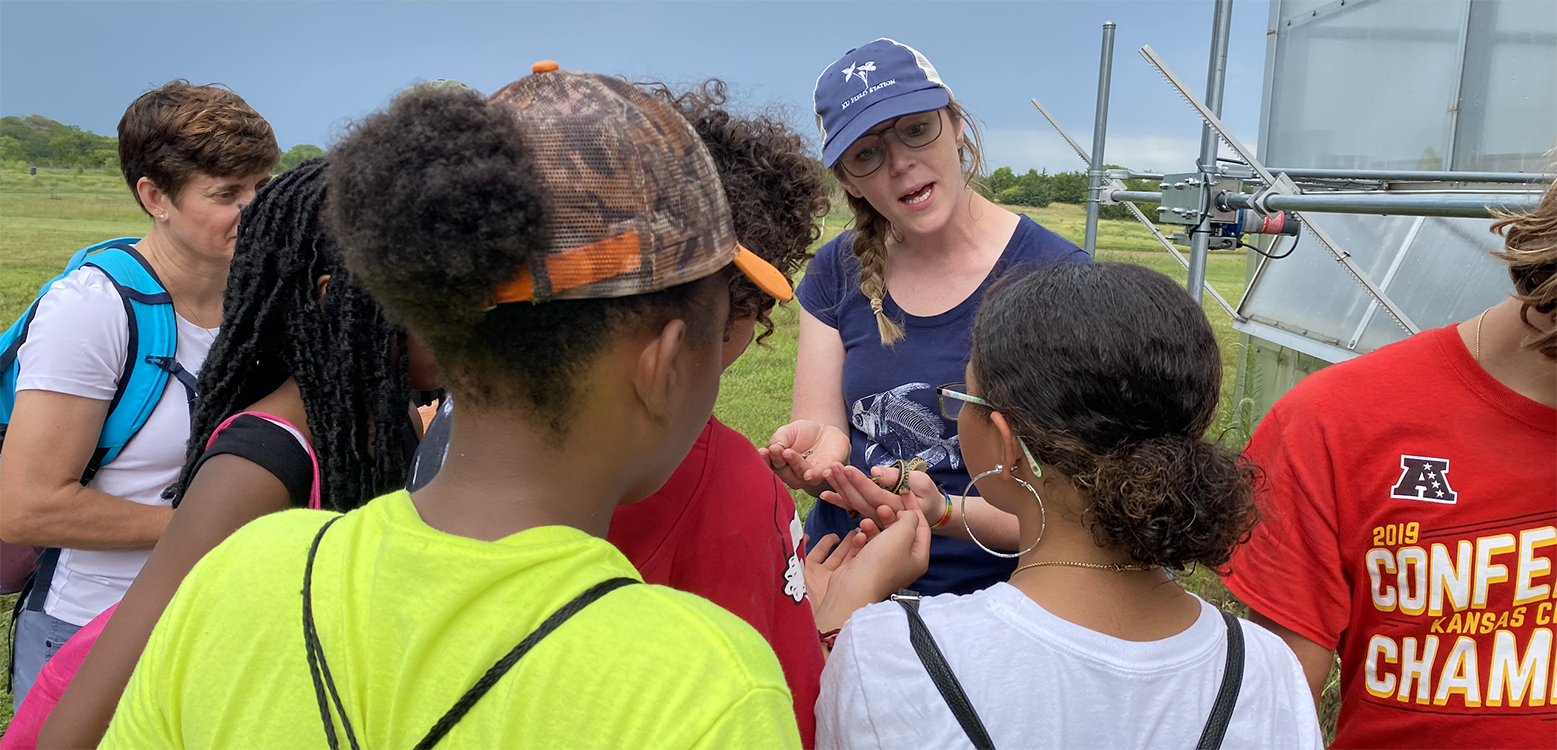
Marcela Paiva is a new graduate student in the Indigenous Studies Program who will have an office in Higuchi Hall and work with Kelly Kindscher through support from a new grant from The Land Institute. Marcela, who is from Chile, is a lawyer and has worked for the Chilean government’s Ministry of Culture and Justice. (Kelly is a senior scientist and professor in the Environmental Studies Program.)
In the Bever/Schultz Lab, Patti Beedles, manager of field experiments, took a new position in June as greenhouse manager with the KU Dept. of Ecology and Evolutionary Biology (EEB). Victoria Hughes, previously an undergraduate in the lab, has taken the position of manager of field experiments. Alexa Phillips, lab manager, is departing for Kansas City. Alex Hoffpauir joins the lab as a graduate student this semester. (Jim Bever is a senior scientist and Foundation Distinguished Professor of EEB; Peggy Schultz is associate specialist and a faculty member in the Environmental Studies Program.)
Angie Babbit, previously outreach coordinator with Monarch Watch, has moved to a new position as research coordinator for the Aquatic Intermittency effects on Microbiomes in Streams (AIMS) project in the Burgin Lab (Amy Burgin is associate scientist and associate professor, EEB and environmental studies). Rob Ramos, previously a doctoral student in the Bever/Schultz Lab, has taken a position as postdoctoral researcher for the (AIMS) project.
The following graduate students are among the GRAs or GTAs working with researchers here this semester; their advisors are listed in parentheses: Adeola Adeboje (Dan Reuman, senior scientist and professor of EEB); Kenneth Ekpetere (Jude Kastens, associate research professor); Atefeh Hosseini (Ted Harris, assistant research professor); Chen Liang (Jude Kastens); Kari Snelding (Amy Burgin); Tokee Tareq (Maggie Wagner, assistant scientist and assistant professor of EEB); and Annalise Guthrie (Bryan Foster, senior scientist and professor of EEB.)
Honors
KU announced in early July that five faculty members had been named distinguished professors. Among them, Sharon Billings was one of two named University Distinguished Professor. KU provides a general description of the criteria for naming Distinguished Professors on its website. The first University Distinguished Professors were announced in 1963. Sharon is a senior scientist and Dean’s Professor of EEB.
Grants, Fellowships and Awards
Ben Sikes has been accepted as a participant in the third annual NASA STAR (Spaceflight Technology, Applications and Research) annual virtual course, which runs from Sept. 20 through Feb. 28. The space biosciences training course was developed for principal investigators, senior research scientists and postdoctoral scholars. Ben is an associate scientist and associate professor of EEB.
Kelly Kindscher has a new $113,000 grant project with The Land Institute, “Silphium ethnobotany and the cultural dynamics of new crop development,” which will focus on Silphium integrifolium, a perennial plant, whose seeds The Land Institute is developing as a sunflower seed replacement. For the past two years, the KU Native Medicinal Plant Garden (KU Field Station site on E 1600 Road next to Prairie Moon School) has had a Silphium integrifolium plot that was part to The Land Institute’s citizen science crop development initiative. Joe Brewer of the KU Indigenous Studies Program is co-investigator.
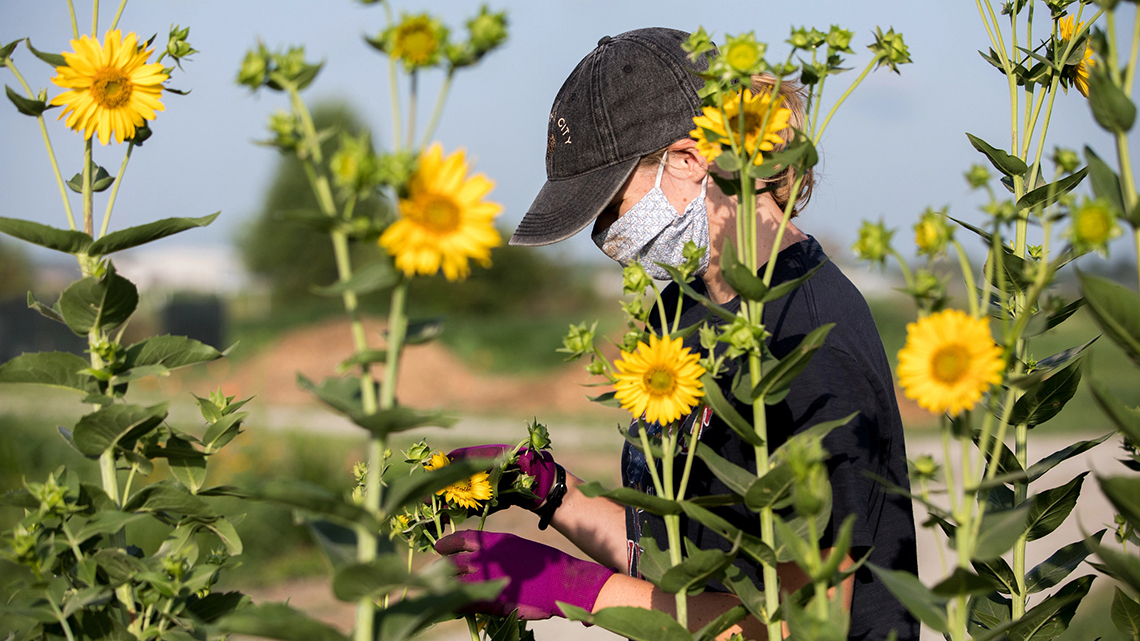
Eric Duell, postdoctoral researcher in the Bever/Schultz Lab, has received a USDA-NIFA (National Institute of Food and Agriculture) Postdoctoral Fellowship, which will enable him to expand some of the ongoing research in the lab. Eric explains that research surrounding the role of grasslands in global carbon storage has increased exponentially over the past few decades. However, we still do not have a clear understanding of the roles that different biotic communities play in this process. The fellowship will allow Eric to examine the effects of plant community diversity on soil microbial diversity, and how these above- and belowground communities interact to influence carbon storage. Another interesting component of this work will allow for the testing of different mechanisms driving these processes, for instance, whether plants and soil microbes influence carbon storage through direct effects, or indirectly through improvements to soil quality.
Kenneth Ekpetere, doctoral student in geography, received a $1,000 KansasView mini-scholarship for his work developing the Rapid Image Viewer Web Application leveraging Google Earth Engine archives. Kenneth is working with Jude Kastens and Xingong Li, professor of geography and atmospheric science, to create a tool for the public, government agencies and researchers to visualize and monitor current and historic landscape- disaster-related events. The WebApp consists of both optical and radar collections from Landsat, Sentinel, MODIS and NAIP imagery. Currently the tool provides data for the U.S. but may extend globally in future developments. The project is funded by the Kansas Water Office. See the beta version of the Rapid Image Viewer WebApp.
Publications
Sharon Billings shares two new publications. The first, “From soils to streams: Connecting terrestrial carbon transformation, chemical weathering, and solute export across hydrological regimes,” in the journal Water Resources Research, is a product of collaboration with Hang Wen, formerly of Penn State, and Li Li, at Penn State, working on modeling processes at the Fitch forest using data obtained from the work of former KU geography faculty member Pam Sullivan. The second is a chapter in a book, Multi-scale Biogeochemical Process in Soil Ecosystems: Critical Reactions and Resilience to Climate Changes. This work highlights how as biogeochemists we work at a fine scale in the lab and field but must inevitably scale our work up to the watershed or landscape level to investigate its broader meaning. Micah Unruh, graduate student in the Billings Lab, took the photo of Sharon below during a week-long trip to do fieldwork in the Calhoun Experimental Forest to dig soil pits, collect samples and install sensors.
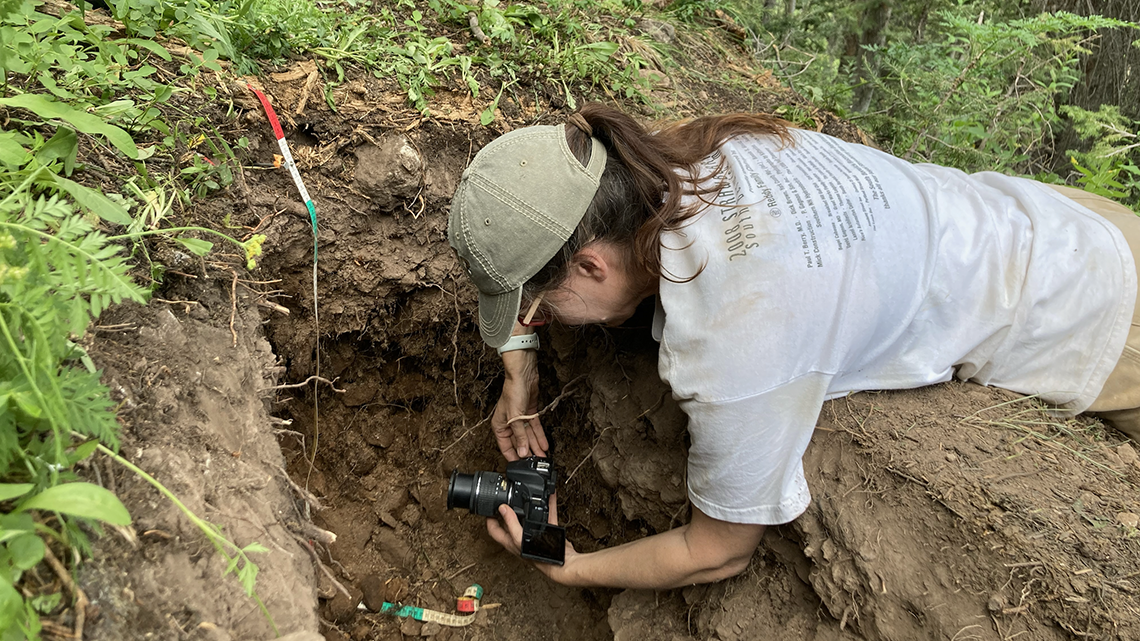
Christopher Rogers, associate research professor, shares his two most recent publications, one on a new species of shrimp from a very rare genus, the other examining the effects of organophosphate pesticides on a federally protected fairy shrimp in California and how this data can be used to develop a risk assessment for the species under federal law:
- “A new species of Tanymastigites Brtek, 1972 (Anostraca: Tanymastigidae) from Libya, with a revised key to the genus and new crustacean records (Branchiopoda, Copepoda, Ostracoda) from Algeria,” published in the Journal of Crustacean Biology;
- “Investigating Vernal Pool Fairy Shrimp Exposure to Organophosphate Pesticides: Implications for Population-Level Risk Assessment,” published in the journal Ecologies.
Jim Bever shares the following new publications:
- “Native mycorrhizal fungi improve milkweed growth, latex, and establishment while some commercial fungi may inhibit them,” published in Ecosphere by Jim Bever, Peggy Schultz, Sheena Parsons and Liz Koziol, assistant research professor.
- “Acaulospora mendoncae (Acaulosporaceae), a new fungal species in the Glomeromycota from maritime sand dunes from southern Brazil,” published in Nova Hedwigia by Jim Beverand colleagues outside KU.
- “Evidence for the evolution of native plant response to mycorrhizal fungi in post-agricultural grasslands,” published in Ecology and Evolution by Camille Delavaux, former doctoral student with the Bever/Schultz Lab, and Jim Bever.
Jude Kastens published “Hydrology of a hydroperiod: Assessing recharge to the High Plains aquifer through a playa in western Kansas,” with co-authors from several institutions, in the Journal of Hydrology.
Eric Duell shares two new publications:
- “Arbuscular mycorrhizal fungi taxa show variable patterns of micro-scale dispersal in prairie restorations,” published in Frontiers in Microbiology;
- “The root‐associated arbuscular mycorrhizal fungal assemblages of exotic alien plants are simplified in invaded distribution ranges, but dominant species are retained: A trans‐continental perspective,” published in Environmental Microbiology Reports.
New Websites
All websites at KU are being moved to a new platform, known as Sunflower, designed by KU Marketing. Mobility and accessibility are key priorities of the new platform. At least three new websites associated with our research center have gone live in the past few weeks:
- our main website, which retains its previous url, https://biosurvey.ku.edu/ (image below shows mobile view of homepage);
- the website for the new Soil Analyses Service Center initiated by Sara Baer, director: https://sasc.ku.edu/; thanks to Aoesta Rudick, Baer Lab manager and research project manager, for her work on this site;
- the website for INVAM, The International Collection of (Vesicular) Arbuscular Mycorrhizal Fungi, https://invam.ku.edu/; this collection was recently transferred from West Virginia University to KU and is now overseen by the Bever/Schultz Lab. Thanks to Terra Lubin, postdoctoral researcher, for her work on this site.
Publicity
Liz Koziol was interviewed for the June article “Restoring Native Prairie Plants? You May Be Missing One Key Ingredient—Fungi” in The Daily Yonder, a digital rural news source produced by the nonprofit Center for Rural Strategies.
Denver magazine 5280 interviewed Kelly Kindscher for a story on the complexities of the harvest of wild oshá plant, “Inside the Debate Over Who Should—and Shouldn’t—Have Access to a Medicinal Plant Called Colorado Cough Root.”
Presentations
Sharon Billings gave a keynote address on her lab’s research at the 8th International Symposium on Physiological Processes in Roots of Woody Plants, held July 10–14 at Penn State University Park Campus in State College, Pa. The following week, at the workshop "Expanding the Critical Zone Research Network" at the Colorado School of Mines, she gave a hands-on workshop on tree sapflux (aboveground) and root quantification (belowground), followed by field work in the Coal Creek watershed in Colorado where she described soil pits, sampled soil, measured water infiltration rates, and photographed roots. The overall workshop focused on broadening participation in Critical Zone Science for the next generation of CZ scholars in Colorado.
In late July, Jude Kastens took part with Ukrainian agricultural economist Antonina Broyaka in a webinar updating war losses in Ukrainian agriculture, “Ukraine Update and Vegetation Signals and Conditions.” The presentation, hosted by AgManager.info, a K-State Research and Extension site, provided a highly detailed report on grain crops and the effect of the war in Ukraine on international agriculture.
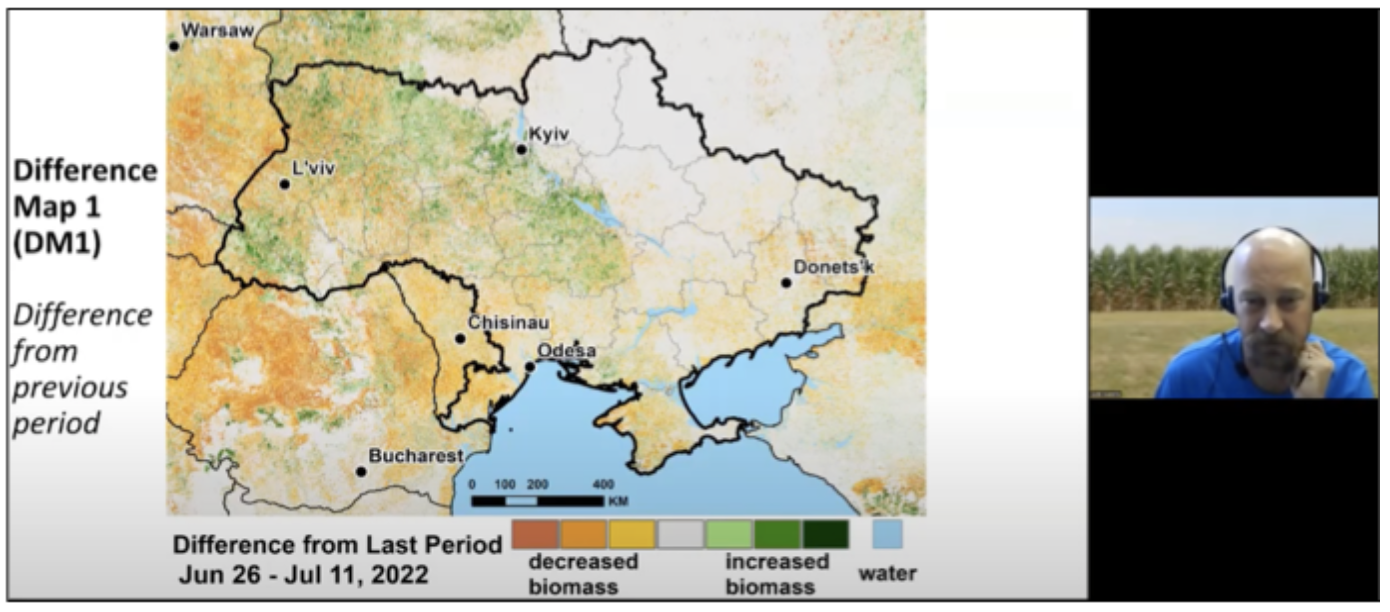
Christopher Rogers is one of four speakers presenting at a KU Medical Center Project ECHO (Extension for Community Healthcare Outcomes) continuing education seminar series, held on Thursdays this month (August), on ticks and tickborne diseases in Kansas. Project ECHO was created at the University of New Mexico nearly 20 years ago to create a knowledge-sharing network that makes health expertise more widely available. KU Med is the first Kansas partner to collaborate with Project ECHO. Health professionals and veterinarians attending the seminar were eligible to receive continuing education credits from the Registry of Approved Continuing Education.
Dissertations
Lígia Souza successfully defended her doctoral dissertation, “Quantifying the depth effects of environmental changes on soil structure and organic matter decay across scales in the Anthropocene,” on Aug. 22. Her advisor is Sharon Billings.
Outreach
At the Aug. 16 City Commission meeting, Lawrence, Kansas, Mayor Courtney Shipley proclaimed September 2022 "The Month of the Monarch" in honor of the 30th anniversary of Monarch Watch, which will hold a variety of events in September.
During the first week of August, a group of middle schoolers from Kansas City, Mo., visited the Field Station as part of Green Works KC's ECO Careers Camp. They met with Wendy Holman, and with Ted Harris and members of his lab, to learn about lakes.
Your Photos
The Harris lab installed a new water quality monitoring buoy on Clinton lake, which will provide data that helps the City of Lawrence better combat taste-and-odor issues in drinking water. Ted Harris took this one of Javier Morales (left), researcher, with undergrads Luke Ungerer (right) and Adeline Kelly.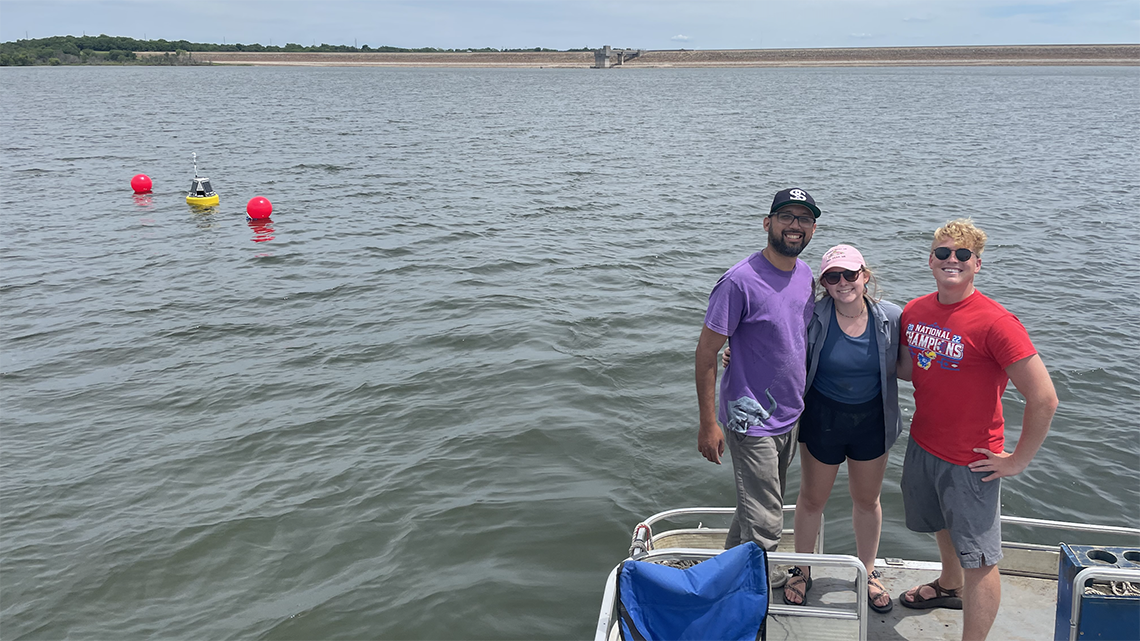
Your Stories
Jennifer Delisle, data manager for the Kansas Natural Heritage Inventory, shares this story that exemplifies the connectedness and long-term commitment of people working to care for native landscapes in the state:
In 2001, Gary Weisenberger of the Kansas Dept. of Transportation visited an Anderson County property to collect seeds for a KDOT roadside restoration. While he was there, he counted more than 100 flowering and vegetative stems of Mead’s Milkweed (Asclepias meadii), a fairly good-sized population for a small remnant prairie, and gave the information to the Kansas Biological Survey. The location was mapped in the database of the Kansas Natural Heritage Inventory, which is housed at our research center and is the state’s sole repository for data about locations of this federally protected milkweed. We regularly use the Inventory to review projects for potential impacts to this rare prairie plant and to work with landowners to preserve the high-quality prairie habitat essential to its survival. No one from the Survey visited the property in 2001, but Kelly Kindscher, community ecologist with the Heritage Inventory, knew Gary.
Fast forward to September 2021. That’s when the landowners met Dena Podrebarac of Monarch Watch at the Baker Wetlands and spoke with her about their 10-acre native prairie. Dena suggested they talk with Kelly about care of the property, and they emailed Kelly and described how KDOT had collected seeds in 2001 and identified the population of Mead’s in the process. Kelly followed up and visited the prairie in this past spring.